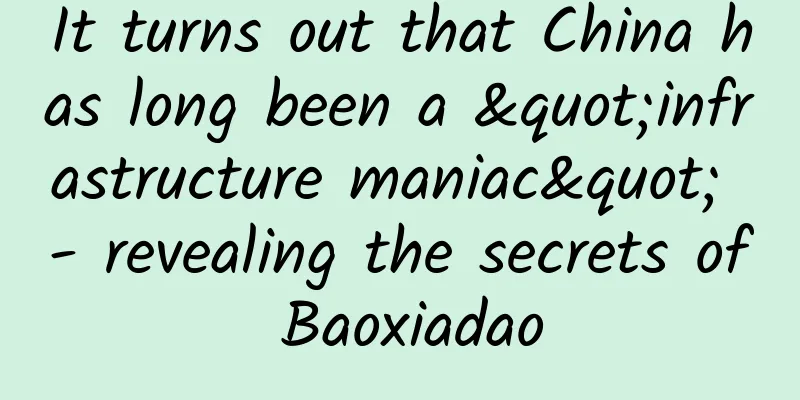It turns out that China has long been a "infrastructure maniac" - revealing the secrets of Baoxiadao

|
In "The Road to Shu", Li Bai used magnificent and bold imagination to show the danger and majestic momentum of the Shu Road. Frankly speaking: "The road to Shu is more difficult than climbing to the sky!" There are two lines in it, "Cancong and Yufu, how confused they were in founding the country! Since then, for 48,000 years, there has been no communication with the Qin border."**** It means that after the establishment of Shu Kingdom, there was no communication between Qin and Shu (now Shaanxi and Sichuan) because they were separated by the Qinling Mountains. The Shu Road is a broad concept with extremely rich connotations. In a broad sense, the Shu Road includes roads leading to the ancient Shu in all directions, as well as roads within the Shu area. The "Shu Road" mentioned in academic research refers to the Baoxiade Road, Ziwu Road, Gudao, Tangluo Road (Tangguang Road) from Guanzhong to Hanzhong, and the Jinniu Road, Micang Road and other plank roads from Hanzhong to Shu. Today, we are going to talk about the Baoxiade Road in the ancient Shu Road, which was an important road in ancient times that crossed the Qinling Mountains and connected Qinchuan. Many parts of the road were plank roads built along cliffs. The Baoxiade Road is named after the Baoxiade Valley. Baoxia Valley is the general name for the valleys of Baoshui and Xiashui (today's Shitou River). It is about 250 kilometers long and has been an important road connecting the north and south of the Qinling Mountains since ancient times. The Baoxiade Road is one of the earliest and largest plank roads in Chinese history. It has been expanded and renovated many times throughout the dynasties and its entire length is more than 200 kilometers. The construction of plank roads had already begun in the pre-Qin period. If the Qin State wanted to occupy the economic zone of Bashu, it had to achieve communication and transportation between Guanzhong and it, as it was blocked by the steep Qinling Mountains. "The Strategies of the Warring States: The Strategies of Qin" records: "The plank road is a thousand miles long, connecting to Shu Han, making the whole world fear Qin." This shows that the construction of the plank road was of great help to the economic and military strength of the Qin State. Building the Baoxiade was not as simple as we imagined. Ancient technology and tools were relatively primitive, and only manpower could make up for these deficiencies. In some parts of the Baoxia Valley, rocks stood upright, and there was a turbulent river below hitting the rocks on the shore. In these parts, it was necessary to chisel stones and lay wood to build plank roads to ensure smooth passage. It is useless to just hammer the hard rocks, so our clever ancestors adopted the method of "fire and water" - first burn the rocks with fire, then pour cold water on them. Due to the thermal expansion and contraction, the rocks will naturally crack, and the workers only need to chisel open the broken rocks. How can we repair the plank road after the huge and hard rock is “moved” away? How can we ensure its stability? The most commonly used structures in plank road projects are the flat beam and straight column structure and the flat beam and straight column plus diagonal brace structure. On this basis, there are versions with a roof cover and also versions without columns due to the depth of water. ①Flat beam and straight column structure When the river water level is low, vertical holes (pillar holes) are first chiseled at the bottom, and solid wood that is not easy to rot is inserted as support; then holes (wall holes) are chiseled on the side stone wall to insert the crossbeam, and wooden boards are laid on the crossbeam, and the plank road with flat beams and straight columns is completed. Zhuge Liang said: "One end of the pavilion beam goes into the belly of the mountain, and the other end is a pillar in the water" refers to the plank road with flat beams and straight columns. In Li Bai's "The Road to Shu is Difficult", the stone planks mentioned in "Then the ladders and stone planks are connected" are the planks that replace the wood of the plank road with stone slabs. Most plank roads will be equipped with railings on the side close to the water to improve safety. ②Flat beam, straight column and diagonal brace structure On the basis of flat beams and straight columns, because the horizontal height difference between the column holes and the wall holes is large and the distance is far, in order to improve the stability of the plank road, some stone holes are chiseled between the wall holes and the column holes. The openings of the stone holes are inclined upward by 25°-30°, and the wood inserted into them is connected to the columns or beams to disperse the load weight. ③Flat beam column-free structure Flat beam column-free plank road, as the name suggests, is a plank road with only horizontal beams installed. Because the river below the plank road is deep and on a steep wall, there is no place to build pillars and diagonal braces, so the only option is to build a simple flat beam plank road. This part of the plank road is relatively dangerous and puts more psychological pressure on pedestrians. The Baoxiade Road not only has these dangerous plank roads, but also the earliest artificial tunnel in my country - the ancient stone gate. Ancient Stone Gate The ancient stone gate is located at the southern end of the Baoxiade Road. It was opened after being repaired and excavated for generations. The cliff inscription "Shimen Song" now in the Hanzhong Museum wrote that Emperor Ming of Han once issued an edict to open the Baoxiade Road and dig the Shimen ("As for Yongping, in the fourth year, the edict opened the Xiade (the original stele said "Yu") and dug the Shimen"), but it was later interrupted due to war; during the reign of Emperor Shun of the Eastern Han Dynasty, the Inspector of the Imperial Capital Yang Mengwen "repeatedly requested" to repair the Baoxiade Road, and Emperor Shun of Han also listened to his advice. In modern times, around 1960, the cultural relics department conducted an on-site investigation and reported the "Baoxiadao Stone Gate and Its Stone Carvings" to the State Council for filing, which recorded: "The east wall of the Shimen Tunnel is 16.5 meters long, and the west wall is 15 meters long; the north entrance is 3.75 meters high and 4.1 meters wide, and the south entrance is 3.45 meters high and 4.2 meters wide; the north and south heights are different, with a height difference of 30 to 50 centimeters from south to north." The inner wall of the ancient stone gate is smooth, with no signs of hammering or smashing. So how was it chiseled through? After the ancient stone gate was chiseled through, the literati and poets who passed through here recorded events and expressed their feelings in writing, which were also engraved on the cliff walls inside and outside the stone gate (a bit equivalent to the current "I was here"??). Over the generations, the spectacular Shimen cliff carvings were formed. Among the numerous Shimen cliff carvings, 13 types from the Han Dynasty to the Southern Song Dynasty stand out and are collectively known as the "Shimen Thirteen Pieces". Unfortunately, the earliest artificial tunnel of Gushimen has been submerged in the Baohe Reservoir due to the national water conservancy project. However, in order to protect the cultural relics, the thirteen pieces of Shimen were chiseled and moved down and are now on display in Hanzhong Museum. Although there are more than one ancient road from Hanzhong to Guanzhong, the Baoxiade Road is shorter and quicker than other plank roads, so it is used more frequently. The Baoxiade Road was burned down and rebuilt several times due to wars. For example, in 206 BC, Liu Bang burned the plank road to "show the world that he had no intention of returning" and to eliminate Xiang Yu's vigilance. Baoxiade is a typical representative of ancient plank roads, and the emergence of ancient plank roads is an important development in my country's transportation. Through the Baoxiade Road, we can feel the wisdom of the ancients. Although the tools and technology were backward at that time, countless ancestors still accomplished this feat of connecting Qin and Chuan. We can feel how important the development and improvement of transportation is to a country's politics, economy and culture. Therefore, China has been making great efforts in transportation infrastructure and is also nicknamed "infrastructure maniac". |
<<: Food Safety | Does sugar-free really mean there is no sugar? You need to know these facts
>>: "The vegetables you love to eat are soaked in formaldehyde to keep them fresh"? !
Recommend
30-meter resolution! New breakthrough in large-scale and high-resolution permafrost mapping in Northeast China
Do you know what permafrost is? As the name sugge...
Some tips for becoming a hardcore programmer
Becoming a core programmer or technical role mode...
The new 4C rule: How to ignite a community at low cost?
As the saying goes, "He who controls the com...
Is it possible that some super theory will emerge in the future that will cause existing physical theories to collapse?
This article is based on answering similar questi...
Business Data Analysis Tutorial
Business Data Analysis Tutorial Resource Introduc...
White is not the base color of the earth!
As my country's urbanization and modernizatio...
11 ways to increase product conversion rate!
Improving conversion rate is one of the core task...
Douban’s methods and strategies for obtaining traffic!
Not long ago, Pinduoduo's market value surpas...
Along with "Black Goku", another trending topic is a research conclusion that "video games are good for health"?
In mid-to-late August, Black Myth: Wukong, the fi...
Oclean One smart toothbrush hands-on experience: a dental care expert with a daily usage cost of less than 1 yuan
Electric toothbrushes have many advantages, but t...
Analysis of the copywriting routines for highly effective Facebook advertising!
Are you facing this dilemma? You have spent a lot...
The inventor of copy and paste has passed away. 50 years ago, she laid the foundation for the basic functions of Word
Evelyn Berezin, the grandmother who invented “cop...
How to create a hit short video?
Why no one watches your short video? How to write...









